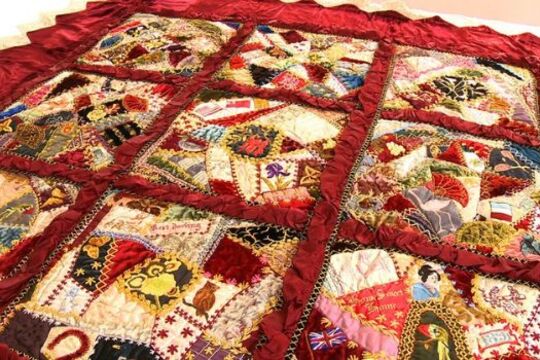Historical information
In this era women of Marianne Gibson's position in society were chaperoned and chauffeured, their role was that of wife and mother, busy in their home. Women did not have the vote and those who worked were servants who lived with families. The Gibson family was well respected in the community and Marianne was the mother of 8 children.
Significance
The Marianne Gibson Quilt is one of the finest examples of crazy patchwork quilting known to exist globally. It features items from her husband's hardware shop, household objects, oriental designs as well as local fauna and flora and the quality of the needlework is outstanding. It is extremely well preserved and unfaded.
For a short film about the Marianne Gibson Quilt, visit Culture Victoria:
http://www.cv.vic.gov.au/stories/marianne-gibsons-crazy-patchwork-quilt/11762/marianne-gibsons-crazy-patchwork-quilt/
Physical description
The Marianne Gibson Quilt is owned by the Wangaratta Historical Society and was placed on the Victorian Heritage Register in 2011.
Marianne Gibson was born in Ireland and 1863 and married her cousin Alexander McCulla Gibson in 1864 in Wangaratta.
The quilt is"...one of the finest examples of a crazy patchwork quilt in the world" (Victorian Heritage Register) and is composed of 9 blocks featuring silks and velvets with a backing of beige silk. The crazy patchwork style popular between 1876 and 1920 encompasses many different patterns that tell stories of that age and uniquely showcases local flora and fauna. Marianne made the quilt between 1891 and 1896. She loved flowers, birds, her garden and especially her family. This is evident in her quilt embroidery and stitching so lovingly demonstrated.
Marianne died on 8th March 1911. She left the quilt to her daughters Clara and Edith who gave it to their housekeeper Miss Alma Gard in 1934. When Miss Gard retired to a nursing home in 1985 the quilt was donated to the Wangaratta Historical Society.
Inscriptions & markings
MG 1891


